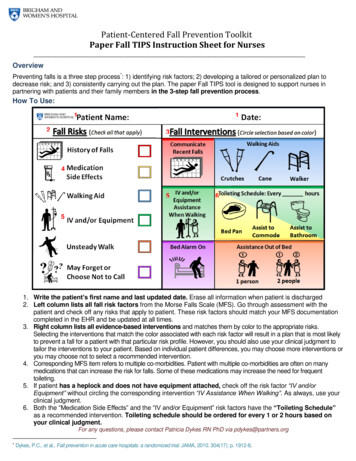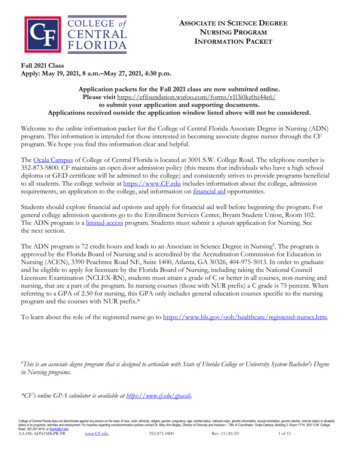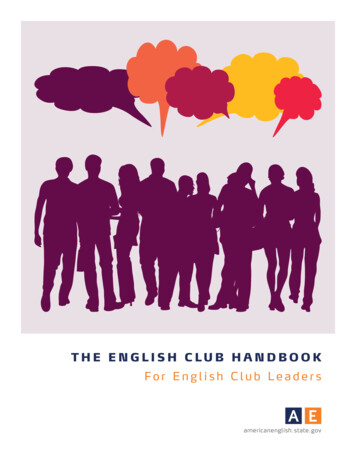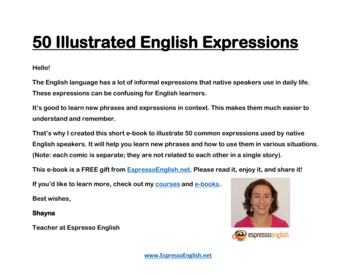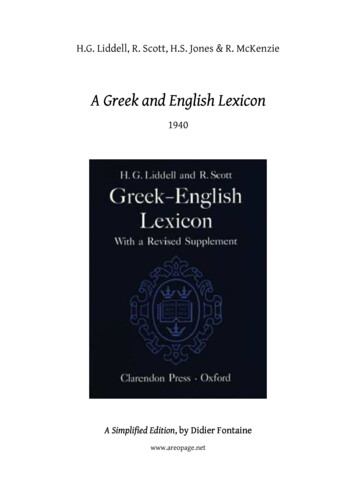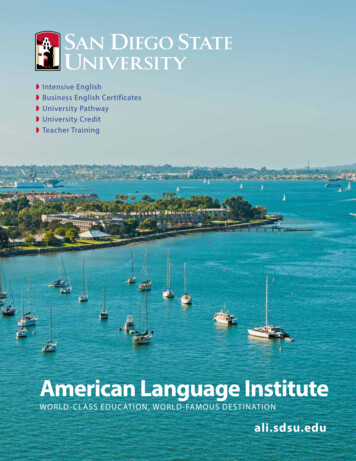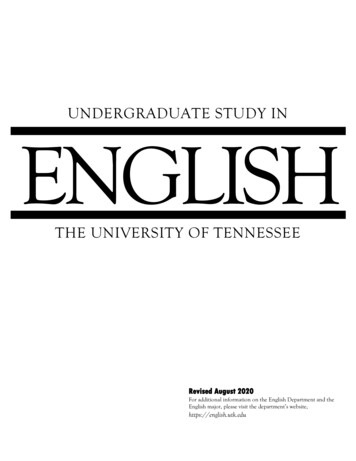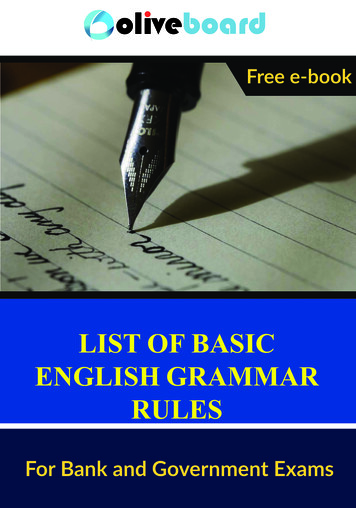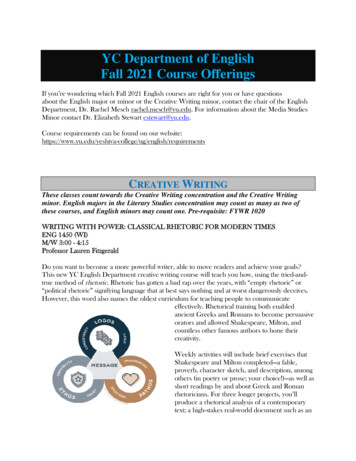
Transcription
YC Department of EnglishFall 2021 Course OfferingsIf you’re wondering which Fall 2021 English courses are right for you or have questionsabout the English major or minor or the Creative Writing minor, contact the chair of the EnglishDepartment, Dr. Rachel Mesch rachel.mesch@yu.edu. For information about the Media StudiesMinor contact Dr. Elizabeth Stewart estewart@yu.edu.Course requirements can be found on our ish/requirementsCREATIVE WRITINGThese classes count towards the Creative Writing concentration and the Creative Writingminor. English majors in the Literary Studies concentration may count as many as two ofthese courses, and English minors may count one. Pre-requisite: FYWR 1020WRITING WITH POWER: CLASSICAL RHETORIC FOR MODERN TIMESENG 1450 (WI)M/W 3:00 - 4:15Professor Lauren FitzgeraldDo you want to become a more powerful writer, able to move readers and achieve your goals?This new YC English Department creative writing course will teach you how, using the tried-andtrue method of rhetoric. Rhetoric has gotten a bad rap over the years, with “empty rhetoric” or“political rhetoric” signifying language that at best says nothing and at worst dangerously deceives.However, this word also names the oldest curriculum for teaching people to communicateeffectively. Rhetorical training both enabledancient Greeks and Romans to become persuasiveorators and allowed Shakespeare, Milton, andcountless other famous authors to hone theircreativity.Weekly activities will include brief exercises thatShakespeare and Milton completed—a fable,proverb, character sketch, and description, amongothers (in poetry or prose; your choice!)—as well asshort readings by and about Greek and Romanrhetoricians. For three longer projects, you’llproduce a rhetorical analysis of a contemporarytext; a high-stakes real-world document such as an
application essay, job letter, and/or resume; and a final portfolio of and reflection on your bestwork of the semester.In the process of learning about classical concepts and applying them to 21st-century situations,you’ll become a rhetorician, able to critically analyze texts and the larger systems in which they areproduced, and a rhetor, adept at using these systems to produce texts that get things done. Becauserhetoric informs all modes of communication, we’ll also learn about making speeches and effectiveways to deploy digital technologies to achieve rhetorical goals.Fulfills the Writing Intensive requirement and counts towards the Media Studies minor.WRITING FOR THE WORKPLACE: TECHNICAL COMMUNICATIONENG 1680T/R 4:30 - 5:45Professor David PuretzThis course explores how people in the working world find,create, and deliver technical information. Learn anddevelop the skills you will need to communicate moreeffectively and more efficiently in your professional life.You will practice collaborative writing with in-depth groupprojects. You will become more proficient with digital andcross-platform communication, including social media andonline content creation and management. And you willlearn the art of simplifying the complex—writing abouttechnical information for non-technical audiences, i.e.managers, coworkers, clients, donors, governmental bodies, the general public, etc.This work will involve: summaries/responses of peer-reviewed technical articles, field researchincluding interviews with professionals in the field, application letters, memos, segmented researchproposals, grant proposals, and feasibility reports. The final class project will include a teamtechnical report and team presentation. Required Textbook: Technical Communication, 13E, byMike Markel.Counts towards the Media Studies minor.
LITERATUREPre-requisite: FYWR or FYWR (H). Literary Studies students take eight literature electives,and Creative Writing students take at least three, in addition to the Advanced Seminar (Fall)and Colloquium (Spring).PRIMARY BONDS:CHILDREN IN LITERATURE AND FILM (WI)ENG 2017T/R 6:45 - 8:00Professor Elizabeth StewartLargely beginning in the 18th century, with major developments throughout the Romantic period,and then throughout the 20th and 21st centuries,children and their lives have exerted a fascination onphilosophers, writers, and readers alike. Childrenappear as mysterious, the “father of the man”(Wordsworth), heaven-sent, and idealized, but also asmartyred, suffering, and the mute representatives ofunthinkable experience; embodiments of innocence,mementos of human kindness, but also devastatingcarriers of the marks of humanity’s worst.Child characters appear with an aura of mystery. In1801, Thomas Reid wrote, “Could we obtain adistinct and full history of all that hath passed in themind of a child from the beginning of life andsensation, till it grows up to the use of reason, thiswould be a treasure of natural history, which wouldprobably give more light into the human faculties,than all the systems of philosophies about them sincethe beginning of the world.” In this sense, art andliterature about children are also about the potentialsthat inhere humanity as such. This course is largely about the psychology and phenomenology ofchildhood—and our fantasies about them.Works by Sophocles, Euripides, Grimms’ fairy tales, Rousseau, Blake, Potok, Kosinski, McEwan,Winterson, Robinson, Kafka, Bulawayo. Films: Heavenly Creatures, Kaspar Hauser, TheChildren Act, Hitler’s Children.
THE 1960s:A POLITICAL AND CULTURAL HISTORYENG 3092T/R 3:00 - 4:15Professor Paula GeyhThis interdisciplinary course will explore the roots, events, ideas, and legacy of the 1960s throughliterature, historical documents, and film. We’ll begin by looking at America in the 1950s toprovide a historical context for the social movements thatdefined the political and cultural history of the 1960s and early1970s. The rest of the course will be organized around thosemovements, including the Civil Rights and Black PowerMovements, the Anti-War Movement, the Youth Movementand Counterculture, and the early Women’s LiberationMovement.Course texts will include Farber, The Age of Great Dreams;Bloom and Breines, Takin’ It to the Streets; Haley, TheAutobiography of Malcolm X; Vonnegut, Slaughterhouse Five;O’Brien, The Things They Carried; excerpts from Kerouac,On the Road and Plath, The Bell Jar, Malcolm X, “The Ballotor the Bullet”; King, “Letter from a Birmingham Jail” and “IHave a Dream”; Hayden, “The Port Huron Statement”;excerpts from Mailer, The Siege of Chicago; excerpts from Hoffman, Revolution for the Hell of It,Woodstock Nation, and Steal This Book; Friedan, Morgan, and Echols. Films will include MakingSense of the Sixties, The Wild One, Selma, Dr. Strangelove, A Hard Day’s Night, The Graduate,The Stepford Wives, Apocalypse Now, Coming Home, and The Big Chill. Requirements: twoessays, an exam, and a presentation.Counts towards the Media Studies minor.THE MOST DANGEROUS QUESTIONS:KING ARTHUR AND THE IDEA OF ENGLANDENG 3024M 6:45-9:15Professor David LavinskyThis class is a study of some keymoments in the legend of KingArthur, perhaps England’s mostcelebrated and enigmatic folkhero. Readings drawn fromearly sources (medieval and earlymodern) will be supplementedwith consideration of the legendin contemporary film (Monty Python and the Holy Grail, dir. Terry Jones and Terry Gilliam,1975) and literature (The Tragedy of Arthur, by Arthur Philips, 2011). Rather than isolate a set of
themes common to all these materials, however, we will explore how transformations in the Arthurlegend raise far-reaching questions about the historical and social work of narrative fiction,especially romance; as one scholar has claimed, “only romance can deal with the most dangerousquestions.” We will investigate this claim in relation to the array of topics introduced by ourArthurian texts: political disaster and dissolution; English national identity and its mythical origins;emotion, ethical conduct, and self-regulation; courtly love and the chivalric code; the earthly andthe spiritual; social change and transformation. These topics will prepare us to consider, duringthe final third of the term, how Arthur and Arthurian legends emerge as potent cultural symbols inTudor England and beyond. No prior background in early English literature or Arthurian materialis assumed. Requirements include regular responses to an on-line discussion forum, a shortcritical essay, and a collaborative multimedia project, together with at least one excursion to theCloisters, the medieval branch of the Metropolitan Museum of Art.Counts for the pre-1700 requirement.ADVANCED SEMINARENG 3005MW 4:30-5:45Professor Rachel MeschThis course explores the kinds of thinking and writingassociated with literary studies, from traditional academicprojects to more creative writing endeavors. Designed for allstudents in both the literary studies and creative writing tracks,the course is meant to build on the work you have already donein English 2010, while preparing you for the student-led seniorcolloquium in your final Spring semester. You should thereforesign up for this course in the Fall semester before the Spring inwhich you plan to take the colloquium. It is advisable to takethe seminar earlier if you intend on a January graduation, rather than taking it in your final Fallsemester. Our focus in Fall 2021 will be on gender and writing, with possible selections from JaneAusten, Charlotte Perkins Gilman, Kate Chopin, E.M. Forster, Carmen Machado, and ToniMorrison. Writing exercises throughout the semester will culminate in a final paper or a creativeproject.Required for all Creative Writing and Literary Studies students in the Fall semester before theyplan to take Colloquium.
CORE COURSESEnglish majors and minors may count two Core courses towards their requirements.BOOKS ON BOOKS, FILMS ON FILMS (INTC)ENG 1001T/R 6:45 – 8:00 or TU/TH 4:30 - 5:45Professor Paula GeyhWhat do literature and film tell us about themselves andeach other? What are the elemental forms and structuresofliterary and filmic narrative? What approaches might oneusefor the analysis of literature and film? How is reading anovel different from “reading” a film? By addressing thesequestions, this course will help students to develop adeeper understanding of how narrative literature and filmwork and how they’re related (or aren’t).The course willbegin by considering the relationship between truth andfiction, and some ideas about what “art” is and does.We’ll examine the roles of readers, film viewers, authors, directors, and critics. We’ll explore theforms and structures of literary and cinematic storytelling, and how these elements come togetherto produce meaning. Finally, we’ll briefly survey various approaches used by scholars and critics toanalyze literature and film.Course texts will include Calvino, If on a Winter’s Night a Traveler; O’Brien, “How to Tell a TrueWar Story”; Cortazar, “A Continuity of Parks,”; Zusak, The Book Thief. Films will include TheWizard of Oz, Sherlock Jr., Stranger than Fiction, Singin’ in the Rain, and Cinema Paradiso.Critical texts will include Plato, The Republic; Wilde, “The Decay of Lying”; Wellek & Warren,“The Nature and Modes of Narrative Fiction,”; Lynn, Texts and Contexts; Rushdie, The Wizardof Oz; and Spadoni, A Pocket Guide to Analyzing Film.Counts towards the Media Studies Minor and the INTC Core requirement.THE HARLEM RENAISSANCE (INTC)ENG 2810T/R 4:30-5:45Professor Ann PetersIn the 1920s and 1930s, between World War I and the Great Depression, African Americanculture experienced a flourishing both in literature and the arts known as the Harlem Renaissance.In this course, we’ll examine literature alongside art and music of the period and learn about someof the events and people that helped create the Harlem Renaissance. We’ll learn, for instance,about the Great Migration, the role of literary magazines in early 20 Century American literaryth
life, the impact of W.E.B. Du Bois, the significance of white patronage in Harlem, and theimportance of Harlem as a cultural center.Readings will include fiction, essays and poetryby writers like Countee Cullen, LangstonHughes, Zora Neale Hurston, James WeldonJohnson, Nella Larsen, Claude McKay, andJean Toomer. We’ll also be watching a shortfilm about jazz, go on a tour of Harlem, andvisit Harlem’s Schomburg Center for Researchin Black Culture. Requirements for the courseinclude an oral presentation, three readingresponse letters (1-2 pages), group discussionforums, and a final literary analysis paper (5-7pages). There will be no midterm or final.Counts for the INTC Core requirement.STRANGER THINGS:THE ART OF THE UNREAL (INTC)ENG 1034M/W 3:00-4:30 (Honors) or M/W 4:30 - 5:45Professor David LavinskyReality is not always probable, or likely.----Jorge Luis BorgesIn this interdisciplinary class, we will study how literature and other media construct fictionalworlds, claimed actualities verydifferent from those we collectivelyperceive and experience. At leastinitially, then, the issues we confrontwillbe epistemological in nature—that is,they will concern how art challengesorotherwise defines the limits of whatwecan know and understand; and yet wewillalso try to push beyond familiartheoretical frameworks (e.g., Plato,Freud) by examining modernphilosophical accounts of literary aesthetics. This work will guide us through a broad range oftextual forms and discourses, from classical epic to contemporary film and television, all variouslymarked by the ramifying proximity of the alien and the familiar, by moments of estrangement andepistemic disruption. To reference the shadowy parallel dimension from the popular televisionminiseries “Stranger Things,” episodes of which we will view, think of the course as a class trip tothe Upside Down and its analogous settings, as afforded by engagements with classical poetry;medieval romance; Arthurian legend; fantasy literature; mystical and visionary writing; magicalrealism; abstract expressionism; and, by the end of the term, science fiction. We will supplement
this diverse assemblage of material with critical and theoretical readings intended for a broadstudent audience. Requirements will include regular responses to an on-line discussion forum,short response papers, at least one critical essay, and a final paper/collaborative multimediaproject, together with excursions to relevant NYC museums, archives, or historical sites.Counts for the INTC Core requirement.FRANCE AND ITS OTHERS (CUOT)ENG 1009HFriday 10:00-12:30Professor Rachel MeschWhile the notion of a cultural “melting pot”is central to American society, Frenchsociety has been structured around adistinctly French notion of universalism: theidea that there are core universal values thatmust supersede those of any minoritysubculture. Thus, although Americansregularly embrace multiple identifications-as African-Americans, or Jewish Americans,for example--in France that double allianceis largely experienced as a tension.This class traces the roots of that tension byexamining ways that otherness has inspiredand troubled the French imaginationthrough literary, historical and philosophical readings by major French writers from the 1500s tothe present day. From Montaigne’s cannibals to the noble savages of Enlightenment texts, fromZola’s “J’accuse!” to the story of Babar, we will explore the myriad ways through which France’simagined others serve as manifestations of a cultural fascination with and anxiety about differencein its many forms. As we analyze the various intellectual conflicts that have arisen from the quest tounderstand what is deemed different, foreign, exotic or strange, we will also trace a struggle todefine and circumscribe notions of French identity, selfhood and authority. Finally, at thesemester’s end, we will use what we have synthesized from these thinkers to considercontemporary debates in French society about the place of religious and ethnic difference in thepublic sphere.Counts for the CUOT Core requirement.
FACE-TO-FACE:COMPLEX MODERN IDENTITIES IN CONTEMPORARY FILM (COWC)ENG 1026TR 3:00-4:15Professor Elizabeth StewartThe basis of identity is to a large extent visual, and images arethe bricks and mortar of what we eventually come to think of ascultural identity. As Aristotle claimed, we learn to becomeourselves by imitating what we see (on the stage) in front of us—for us, the film screen—and we become ourselves by imitatingour cultural ideals. This course explores the role cinematicimages play in creating narratives about a multiplicity of culturalidentities. Aristotle also insisted that it is the “ideal” charactercreated on the stage who will aid in creating “ideal” citizens. Inother words, Aristotle knew that the visual/verbal arts—in hiscase, theater, in our case film—have not only a representativefunction, but an ideological one as well. But cinematic images, like images in the other arts, havealso held the function of “naturalizing” certain structures of oppression and domination as well aschallenging them. This course will explore how American and foreign film represents variousracial, class, gender, ethnic, and national identities, and how they reproduce and challenge thoserepresentations at the same time. While the course pays attention to both cognition and affect inour reception of film, it will emphasize the study of affect in cinematic identification, projection,and enjoyment. FILMS: Zelig, Birth of a Nation, Moonlight, Fight Club, Picnic at Hanging Rock,Rear Window, Caché, Force Majeure, Beasts of No NationRequirements: class participation, short responses, 2 critical essays.Counts towards the Media Studies minor and for the COWC core requirement.Visit http://www.yu.edu/yeshiva-college/ug/english/ to find out more aboutthe YC English Department and its faculty and the English major andminor. Visit https://www.yu.edu/yeshiva-college/ug/writing to learn aboutthe Creative Writing minor—and for links to the Creative Writing minorand the Media Studies minors’ webpages.
This interdisciplinary course will explore the roots, events, ideas, and legacy of the 1960s through literature, historical documents, and film. We’ll begin by looking at America in the 1950s to provide a historical context for the social movements that defined the pol

